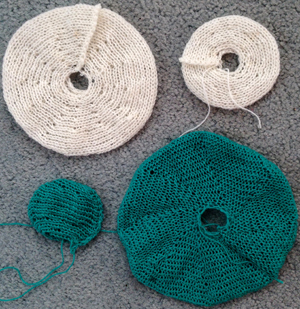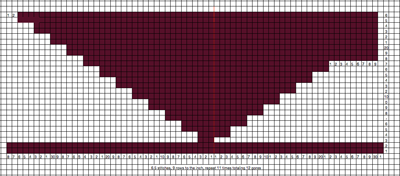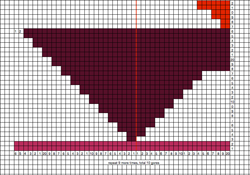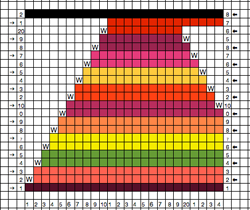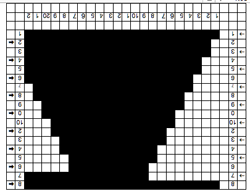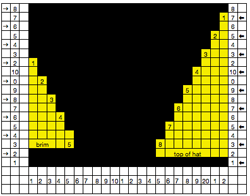These forms involve bilateral shaping. 3/4/16 Note: the charts below were produced using the program Intwined, which has been unsupported or updated for Mac since June 2013. At that time I encountered major problems using it, and after being restored the program has remained unpredictable, missing functions that influenced my choice to originally purchase it. The first row knit needs to be toward the first 2-row sequence in the design.
16 stitches, 6 rows, 8 repeats
28 stitches, 12 rows, 8 repeats
17 stitches, 8 rows, 12 repeats
28 stitches, 10 rows, 12 repeats
The samples were knit in “waste” yarns, and seamed on the machine; if turned purl side out the latter is acceptable, or work could be flipped over and joined on the machine, bringing the join to the purl side; of course Kitchener stitch is always the least visible but most time-consuming option. The green forms in the photo were knit using 8 repeats, the white ones 12)
Back to charting in Excel: knitting tams
tam 1: 6.5 sts and 9 rows per inch, 12-inch diameter, 12 gores, 38L, 30R
adjust for gauge: mine below on bulky machine tension 3, ap 5 sts , 5.72 rs per inch, 10 gores, 26L, 20R
test swatch, if fewer rows are needed for head circumference formed on rt, first 2 rows may be skipped every third round or as needed, extra red rows on top may be added if additional width is needed to fit head comfortably
my hats in 2 different fibers, sizes M and L
going bulkier for an “urchin”: 2.5 sts, 5 rs per inch, 8 gores
step 1, HK, W = wrapped st
a way to size up, adding rows and sts
gauge may be hard to match even eon on bulky. HK version, flipped so as to knit increasing angle, no wrapping required with any of my yarns in this series, test swatches suggested
looking at it another way
in the above, the black represents knit stitches, arrows indicate the direction of knit/ reading the chart, the yellow the unworked stitches in each row, no wraps; my sample was knit in garter stitch on size 11 needles, brim circumference = 21 inches
…
Programming for use of repeats on knitting machines (there are limitations based on gauge and machine model): black/colored squares represent knit stitches. When the machine is set to slip, those squares/punched holes will knit, while blank areas/non-selected pattern needles will not, emulating holding techniques. Knit rows need to happen toward 2-row sections of charts so that needles are “brought to hold” opposite the carriage; KC (II, no end needle selection) row needs to start the carriage on the side opposite to the first such sequence. For example: in the charts, for the balls, the KC row would be from left to right, the first knit row from right to left, with the first set of needles to be “held” opposite the carriage on the second knit row. The principle is considered throughout, and the last row knit across all stitches will get the carriage back to the required position for beginning the sequence for the next segment. When knitting on the machine, if the row counter tripper is turned off, the RC may be advanced manually as each wedge is finished. Tracing on the charts for such stitches, pretending to be knitting, and following with a writing instrument the direction/movement of the carriage to each side helps to clarify the process and find possible errors or more needed rows prior to actual knitting.
If Kitchener stitched together, finished hats will be reversible, may be worn in a variety of ways, and takes on a slightly different shape depending on which side is worn on the outside. An excellent series on Kitchener stitch may be found on the TECHknitting blog
http://techknitting.blogspot.com/2007/05/easier-way-to-kitchener-stitch-also.html
http://techknitting.blogspot.com/2012/11/step-by-step-kitchener-stitching-with.html
http://techknitting.blogspot.com/2012/11/kitchener-stitching-grafting-with.html
http://techknitting.blogspot.com/2012/12/shaping-in-kitchener-row-useful-for.html
garter grafting video
http://www.youtube.com/watch?v=BAEIogIli6o
if blocking of hat forms is required, plates may actually come in handy
if the brim is too loose, work one or 2 rows of crochet or of knitted rib to gather it in a bit




